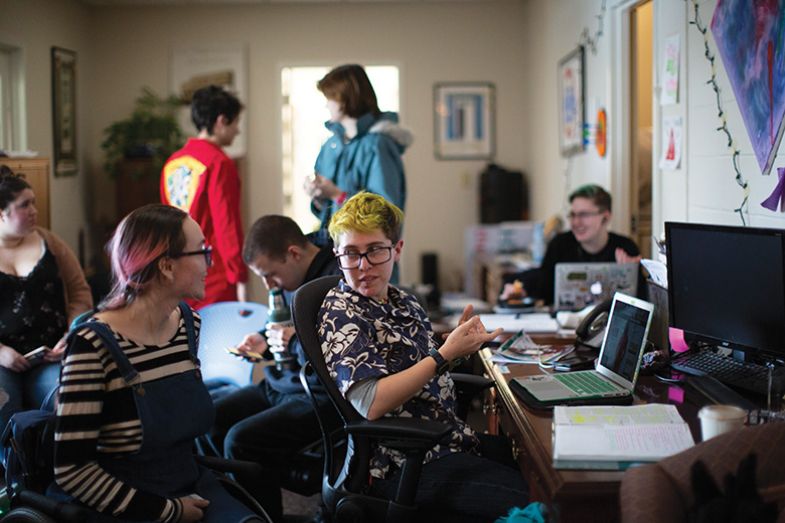We have spent most of our professional lives teaching in liberal arts colleges and have come to love their energy and dedication. We have watched as generations of our students took ownership of their own learning and became advocates of their education rather than passive witnesses to it. We have formed steady friendships with scores of graduates who, regardless of their myriad career paths, remain engaged with their communities and devoted to what in Hebrew is called tikkun olam, repairing and making the world a better place. If this seems both clichéd and exaggerated, perhaps it is. But it is also what liberal arts colleges seem uniquely capable of.
With a high percentage of residential students and a dedication to small interactive classes, liberal arts colleges inevitably represent only a small part (less than 6 per cent) of US higher education. Yet abundant research suggests that these “college-universities” demonstrate positive student outcomes not found in other American higher education institutions. As Francis Oakley, former president of Williams College in Massachusetts, has noted, they offer their undergraduates “an undistracted and undiffused intensity of focus on a broadly based education in the arts and sciences which has long become wholly extraordinary”. They have been quick to adopt innovative curricular and pedagogical approaches, and their graduates excel in STEM fields as well as the humanities.
Liberal arts colleges typically produce more science and engineering students who continue on to PhDs than other US undergraduate institutions, controlling for size. According to the latest figures from the National Science Foundation, from 2002 to 2011, liberal arts colleges accounted for 27 of the top 50 sources of science and engineering doctorates when ranked by number of doctoral recipients per 100 bachelor’s degrees awarded in all fields nine years earlier. Jennifer Doudna, who has just shared this year’s Nobel Prize in Chemistry, originally studied at Pomona College in California. Liberal arts graduates now also make up a larger percentage of the tech workforce than technical graduates.
Furthermore, liberal arts colleges, unlike research-intensive or large state universities, have long stressed social concerns alongside the success of their graduates as individuals. A substantial majority of them are guided by missions that signal their “enduring commitment to a sustainable and just society” (Oberlin College in Ohio) or express a desire to “support and create positive change in their communities and the world” (DePauw University in Indiana).
All this is very much to be celebrated, yet unfortunately it is only one side of the coin. We worry that, rather than taking advantage of their small size and residential nature, these colleges are replicating the departmental structures characteristic of much larger universities and holding fast to traditional pedagogies and curricula that do not adequately prepare students for the world they will face. We have also become increasingly frustrated by how these colleges, including our own, reproduce wider structures of economic exclusion and systemic racism. Although they are hardly alone in this, they have frequently become engines of inequality, using selectivity as a mask for elitism.
Since they tend to have fewer than 3,000 students, liberal arts colleges typically receive more applications than they have places. But the inevitable process of selection has often been turned into a celebration of inaccessibility, justified by an ideal of meritocracy that assumes hard work and talent will be rewarded. The result, as Harvard political philosopher Michael Sandel, the author of a new study on The Tyranny of Merit, recently told Times Higher Education, is that “those who have landed on top have come to believe that their success is their own doing and they therefore deserve the benefits the market bestows on the successful”.
Yet, in reality, educational “merit” is determined within the confines of an unequal and highly segregated school system that consistently favours the children of the wealthy. Selection determined by a tainted meritocratic ideal drives colleges to expend scarce resources in a furious battle for “the best” students. It also perpetuates and extends the racism that has long marked American schools.
As Sandel and others have pointed out, highly selective recruitment to colleges justified by meritocracy produces a mountain of “losers”. But it also generates “winners” who are burnt out from an assessment-crazed, high-stakes testing culture in schools long before they ever set foot in our classrooms. Turning the Tide, a recent report by a consortium of teacher educators led by the Harvard Graduate School of Education, made clear the need to rethink current admission processes that, it warned, pose a direct threat to applicants’ mental health.
Faculty feel this, too, and it leads all too often to a cycle of cynicism and inertia, a sense that we’re just ticking boxes. This can be seen in the narrow disciplinary limitations that keep students (and faculty) from making deep connections across the curriculum and with the local community. It is also a feature of the anachronistic institutional structures that lead departments to work harder to guard their resources than to build meaningful learning opportunities geared to creative problem-solving in the “real world”.
While the same dysfunctions can be observed in other institutions of higher learning, it is deeply disturbing to find them so prevalent in small liberal arts colleges, whose mission statements speak directly to concepts of social justice, equity and inclusion. We call on them to live up to their stated ideals – ideals that make them uniquely placed to respond to today’s crisis-prone world – and offer a model, at this do-or-die moment, for more inclusive and just institutions of higher learning.
Our recent book, The Post-Pandemic Liberal Arts College: A Manifesto for Reinvention (Belt Publishing), looks in detail at what such colleges need to be doing differently. In essence, everything hangs on their ability to create what Isabel Roche, president of Bennington College in Vermont, calls a culture of “productive restlessness”. Rather than yet another strategic plan, we need to begin shifting the culture of small liberal arts colleges to create institutions that can address the serious problems of democracy and inclusion by admitting students (and hiring faculty) who embody different, often remarkably challenging, lived experiences; that will prepare students for a complex world by empowering them to take ownership and responsibility for their own learning; and that promote collaboration across fields and with local community members.
For us, this cultural shift begins by filling our colleges with staff and faculty who understand what they are capable of delivering, people who recognise that the pedagogical strategies for which we advocate have everything to do with creating classrooms that meaningfully represent the racial, ethnic, religious, socio-economic, cultural and sexual diversity of the US and the world. These are classrooms that develop practices of shared power, individual and collective responsibility, critical thinking, democratic discourse and collaborative problem-solving – and, in doing so, prepare our students to be creative agents in the world beyond graduation.
We believe that this cultural shift has major implications for how small liberal arts colleges hire faculty. Fundamentally, however, it requires an acknowledgement that we will continue to produce institutions that privilege, well, the privileged until we collectively commit to rejecting the controlling hand of elitist ranking systems and adopt admissions practices that target a wider audience, emphasising students’ lived experiences over “college- and career-ready” data points.
We are encouraged that some national efforts designed to radically challenge existing admissions procedures are already under way. For example, an initiative at the public university level, “Hack the Gates: Radically Reimagine Admissions”, proposes to identify and remove “systemic barriers to college access for low-income students and students of color” and to “create more equitable pathways to post-secondary education”. We would encourage similar initiatives among smaller liberal arts colleges.
We believe we have the capacity to create institutions that look outwards and that align with the principles of social entrepreneurism, beginning by tackling problems that need solving. Some colleges are moving in this direction by enhancing a team-based approach to learning and curriculum design, building student-centred, problem-based concentrations that often develop deep community engagements. Goucher College in Maryland, for example, helps faculty design courses based on a set of questions including: “If you were going to create a course that would help students who knew nothing about your discipline fall in LOVE with your field and see its value in today’s world, what would that look like? If we want students to integrate their learning and also work well with others to solve complex problems, how do we help foster those skills?” Other colleges, such as Ohio’s Oberlin, are developing explicit learning objectives for what educational theorist Randy Bass calls “dispositional learning”, helping students cultivate attitudes towards life and learning such as conscientiousness, resilience, self-regulation and reflection.

This raises an obvious but fundamental question. Why will small liberal arts colleges adopt these measures now when they haven’t made a concerted effort to do so previously?
The answer, we suggest, is all around us. Like it or not, we are facing no fewer than three major crises on top of the Covid-19 pandemic: responding justly and imaginatively to four centuries of anti-black racism; addressing an accelerating climate crisis; and countering the threat to democracy as elected leaders abandon ethical norms and promote violence. The colleges that survive will be those that best prepare their students to confront these crises. This was the argument of Ed Wingenbach, president of Hampshire College in Massachusetts, who recently observed that students will increasingly want to “think about their college educations as an opportunity to begin addressing those relevant, meaningful existential problems that their generation is going to be tasked to solve”. Colleges, he continued, “that shift their emphasis in their curriculum and their approaches in ways that invite students to actually engage [with] those questions as part of their core curriculum and their experience rather than the thing they're going to do after they graduate will benefit”. Students at Hampshire are required to “forge your own path, taking roads not already paved for you” and to demonstrate an ability to use their knowledge in successively more sophisticated projects of their own design.
Hampshire is not alone in the ongoing process of reimagination. Hiram College in Ohio recently moved to organise academic courses around five interdisciplinary “schools”, such as health and community advocacy, and education and civic leadership, realising that offering students pre-packaged majors that resemble a “watered-down graduate school” simply won’t prepare them adequately. The most recent learning goals drafted by faculty at DePauw University, Indiana, also emphasise those that centre on application, innovation, harnessing technology, and independent and collaborative problem-solving.
These changes are not a rejection of the liberal arts model. Rather, as Wingenbach argues, they represent “a return to the heart of the liberal arts, based on a realist’s sense that the crisis of the 21st century, which is a crisis across lots of different domains, can only be solved by...creative, open-ended thinking”.
Although we have to fundamentally reconsider our financial models to create the infrastructure for this vision (and we offer a number of suggestions in our book), we believe that a considerable amount of the heavy lifting can be done by the colleges themselves if they act in concert, support need-blind admissions and reject costly approaches that put them in fierce competition for students.
Small liberal arts colleges have a long history as pioneers in higher education, and this moment of crisis offers them a choice. They can either continue along the path that leads to greater elitism, celebrating the “inaccessibility” that David Labaree, a professor at Stanford University’s School of Education, recently argued has become “baked in” at selective research universities. Alternatively, they can harness their innovative potential to imagine and implement a more just and inclusive model that is more relevant to today’s students. To survive, we are convinced that our institutions must adopt the latter option.
Steve Volk is professor of history emeritus at Oberlin College. Beth Benedix is professor of world literature, religious studies, and community engagement at DePauw University.
后记
Print headline: A power for enduring good





